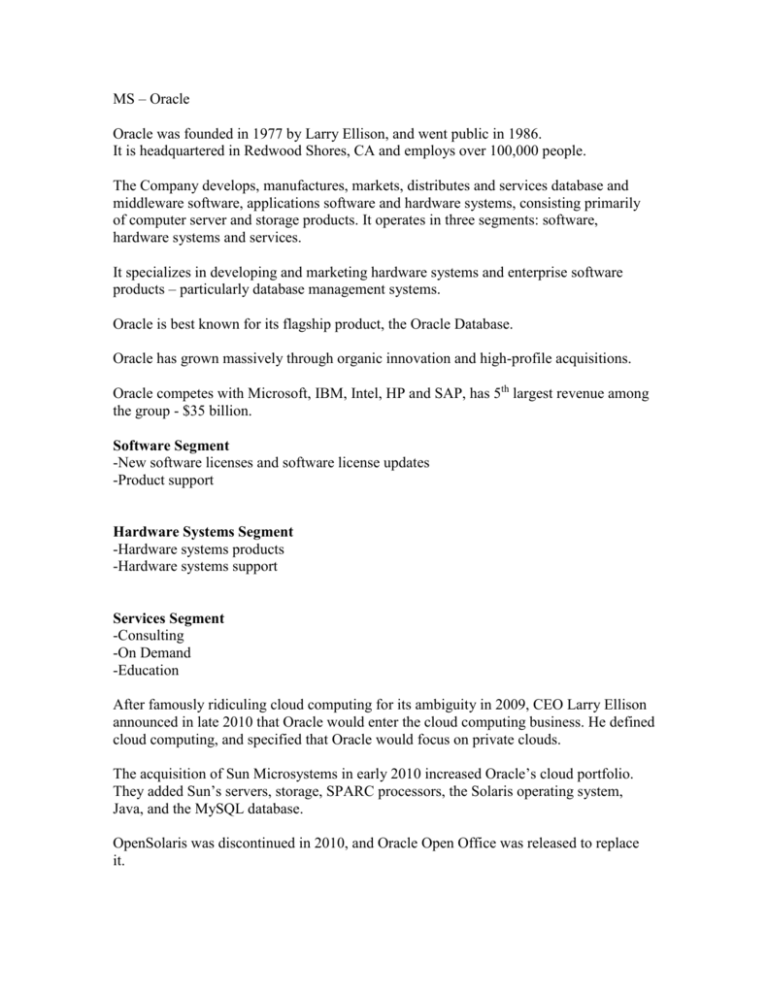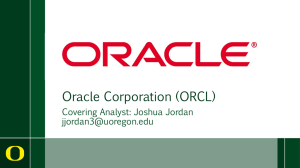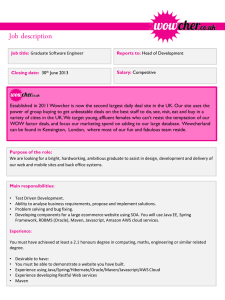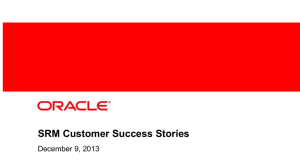Oracle Cloud Computing
advertisement

MS – Oracle Oracle was founded in 1977 by Larry Ellison, and went public in 1986. It is headquartered in Redwood Shores, CA and employs over 100,000 people. The Company develops, manufactures, markets, distributes and services database and middleware software, applications software and hardware systems, consisting primarily of computer server and storage products. It operates in three segments: software, hardware systems and services. It specializes in developing and marketing hardware systems and enterprise software products – particularly database management systems. Oracle is best known for its flagship product, the Oracle Database. Oracle has grown massively through organic innovation and high-profile acquisitions. Oracle competes with Microsoft, IBM, Intel, HP and SAP, has 5th largest revenue among the group - $35 billion. Software Segment -New software licenses and software license updates -Product support Hardware Systems Segment -Hardware systems products -Hardware systems support Services Segment -Consulting -On Demand -Education After famously ridiculing cloud computing for its ambiguity in 2009, CEO Larry Ellison announced in late 2010 that Oracle would enter the cloud computing business. He defined cloud computing, and specified that Oracle would focus on private clouds. The acquisition of Sun Microsystems in early 2010 increased Oracle’s cloud portfolio. They added Sun’s servers, storage, SPARC processors, the Solaris operating system, Java, and the MySQL database. OpenSolaris was discontinued in 2010, and Oracle Open Office was released to replace it. “Oracle Cloud Office and Oracle Open Office 3.3 deliver complete, open and costeffective office productivity suites that are designed and optimized for our customers’ needs,” said Michael Bemmer, vice president of Oracle Office. “Customers now have the flexibility to support users across a wide variety of devices and platforms, whether via desktop, private or public cloud. With Oracle Office, enterprises can reduce costs while helping to increase productivity and speed innovation.” PaaS The Oracle Platform for SaaS includes Oracle Database, Oracle Fusion Middleware, Oracle Enterprise Manager, and Oracle VM, a comprehensive, open and integrated set of technologies that allow ISVs to build, deploy, and manage SaaS and cloud-based applications. The Oracle Platform for SaaS is infrastructure software that allows developers to build, deploy and manage SaaS and PaaS offerings that are enterprise grade. Today, Oracle offers two SaaS applications: Oracle CRM On Demand, an easy-to-use subscription-based CRM for sales, service, marketing, and contact-center operations Oracle Argus Safety, an advanced drug safety and risk management solution for life science companies Oracle On Demand includes hosted and managed applications and remote application management services, as well as subscription-based SaaS applications. Oracle is not an IaaS provider, but Oracle works with IaaS providers such as Amazon Web Services in order to give enterprises the flexibility to choose to deploy Oracle technology in either their own private cloud or public clouds. Oracle Grid Grid computing enables groups of networked computers to be pooled and provisioned on demand to meet the changing needs of business. Instead of dedicated servers and storage for each application, grid computing enables multiple applications to share computing infrastructure, resulting in much greater flexibility, cost, power efficiency, performance, scalability and availability, all at the same time. Private Cloud - Oracle enables enterprises to run Oracle technologies in either private clouds or public clouds like Amazon Web Services Oracle Exalogic Elastic Cloud is the world's first and only integrated cloud machine— hardware and software engineered together to provide a "cloud in a box". Exalogic is designed to revolutionize data center consolidation, enabling enterprises to bring together tens, hundreds, or even thousands of disparate, mission-critical, performance-sensitive workloads with maximum reliability, availability, and security. Oracle Exalogic's unique high-bandwidth, low-latency interconnect fabric means that complex, distributed applications can run with a responsiveness simply not achievable with typical servers used in data centers today. Oracle has two cloud computing objectives. The first is to ensure that cloud computing is fully enterprise-grade to enable enterprise adoption. Enterprise-grade means high performance, scalability, availability and security, and it means standards to ensure portability, interoperability and no vendor lock-in. The second objective is to support both public and private cloud computing to give customers choice. To meet these objectives, Oracle has three strategies: a. Offer customers a growing number of applications as SaaS services b. Provide enabling technology to other cloud providers c. Give customers the choice to deploy Oracle technologies in either private clouds or public clouds - http://www.oracle.com/us/technologies/grid/025607.htm






